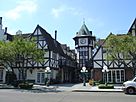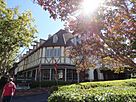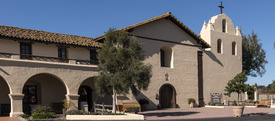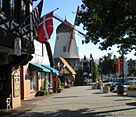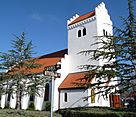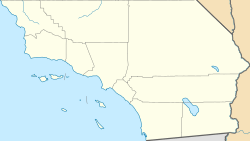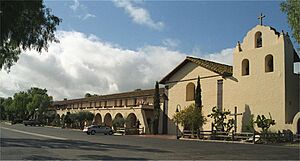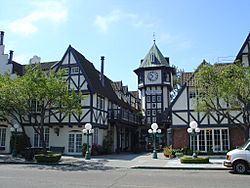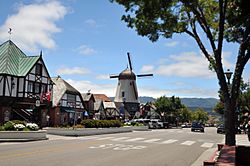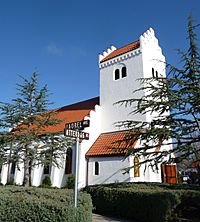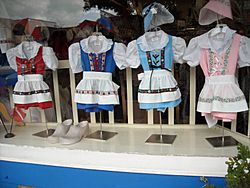Solvang, California facts for kids
Quick facts for kids
Solvang, California
|
||
|---|---|---|
|
Top: Tivoli Square, Petersen Village Inn; middle: Mission Santa Inés; bottom: Solvang windmill, Bethania Church
|
||
|
||
| Nickname(s):
Danish Capital of America
|
||
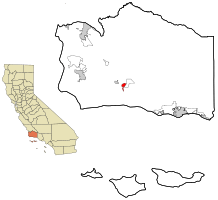
Location in Santa Barbara County and the state of California
|
||
| Country | United States | |
| State | California | |
| County | Santa Barbara | |
| Incorporated | May 1, 1985 | |
| Area | ||
| • Total | 2.43 sq mi (6.28 km2) | |
| • Land | 2.42 sq mi (6.28 km2) | |
| • Water | 0.00 sq mi (0.00 km2) 0.05% | |
| Elevation | 505 ft (154 m) | |
| Population
(2020)
|
||
| • Total | 6,126 | |
| • Density | 2,521/sq mi (975.5/km2) | |
| Time zone | UTC−08:00 (PST) | |
| • Summer (DST) | UTC−07:00 (PDT) | |
| ZIP Codes |
93463-93464
|
|
| Area code | 805 | |
| FIPS code | 06-72576 | |
| GNIS feature IDs | 1661468, 2411925 | |
Solvang (/ˈsɒlvæŋ/; Danish for "sunny field") is a city in Santa Barbara County, California, United States. Located in the Santa Ynez Valley, the population was 6,126 at the 2020 census, up from 5,245 at the 2010 census. Solvang was founded in 1911 and incorporated as a city on May 1, 1985. Solvang has been described as "The Danish Capital of America".
In 1804, Mission Santa Inés was founded by the Spanish under Esteban Tápis. A small community grew up around the mission called "Santa Inés" during the Mexican period, but it was largely abandoned after the American Conquest of California. In 1911, a new settlement was founded around the mission by a group of Danish Americans who purchased 9,000 acres (3,600 ha) of the surrounding Rancho San Carlos de Jonata, to establish a Danish community far from Midwestern winters. The community began building Danish-themed architecture in 1947, and has since become a tourist destination. The community attracts tourists from Nordic countries, and has been the subject of several Danish royal visits including Prince Henrik in 2011. A minority of residents in the 21st century are of Danish origin.
Contents
History
Beginnings
The Santa Ynez Valley, in which Solvang lies, was originally inhabited by the Chumash, identified by Father Pedro Font, chaplain of the 1776 Anza Expedition, and were described as an ingenious and industrious people who are good fishermen and hunters, with an excellent astronomical system.
As part of the expansion of the mission system established in California by Spanish missionaries, Father Estévan Tapís founded Mission Santa Inés, now located near the center of Solvang, in order to relieve overcrowding at Mission Santa Barbara and Mission La Purísima Concepción since it was located midway between the two. It also served as a gateway to the Chumash Indians living east of the Coast Range.
After the Mexican War of Independence, the Mexican Assembly passed the Secularization Laws which confiscated Mission lands, along with other property, and transferred them to the control of local ranchers, with Solvang being later founded on what became known as the Rancho San Carlos de Jonata. With secularization, Mission Santa Inés began to decline and the Chumash Indian population in the area along with it. For a time, the mission was a seminary but soon began to deteriorate; it was repaired by the Donahue family in 1884 and renovated by Fr. Alexander Buckler in 1904.
Danish settlement
In 1910, Danish-Americans created the Danish-American Colony Company in San Francisco. Later that year, suitable land was found in the Santa Ynez Valley northwest of Santa Barbara, and in 1911, they acquired almost 9,000 acres (36 km2) of the Rancho San Carlos de Jonata land grant, paying an average of $40 per acre.
A hotel was built close to the Mission where new arrivals could be housed, and a school opened in 1911, with 21 students.
Expansion
In 1912, when it became difficult to sell any more plots of land, developers from Solvang travelled to Iowa and Nebraska to persuade Danish immigrants to buy land in the town. This attracted new settlers. The early settlement had a store, a bank, a lumber yard, a barbershop and a post office.
Folk high school
In 1914, Atterdag College opened, named after Valdemar IV of Denmark. The school taught Danish-speaking students in their late teens a curriculum that emphasized lectures, singing, gymnastics, folk dancing and fellowship. During World War I, enrollment dropped due to reduced Danish immigration, and a rise in nationalism. The school was sold to the Solvang Lutheran church in 1921. Atterdag College continued to be used as a folk school, community meeting hall, performing arts venue, gymnastics center, summer school, and boarding house until it was demolished in 1970, and then replace by the Solvang Lutheran Home.
Danish church
The Bethania Evangelical Lutheran Church opened in 1928, designed as a Gothic-styled, 14th century rural Danish church. Originally, the services were mainly in Danish, but are now in English.
Danish-styled architecture
Initially, most of Solvang's buildings were built in the same style as others in the area. The Lutheran church was the first to be based on Danish architecture and bears a close relationship to Danish equivalents. But after World War II, interest grew in the concept of a "Danish Village". The pioneer of the Danish Provincial style was Ferdinand Sorensen, originally from Nebraska. In the mid-1940s, after returning to Solvang from a trip to Denmark, he first completed Møllebakken, his Danish-styled home, and then went on to build the first of the village's four windmills. A little later, Earl Petersen, a local architect, gave the older buildings a new look, adding façades in so-called "Danish Provincial" style. Buildings in the half-timbered style of Danish rural houses proliferated, creating a new tourist attraction. While much was done to create an "authentic" Danish atmosphere in the town center, it has been pointed out by Scandinavians that fake thatched roofs and artificial timbering are largely a result of local interests in general rather than those of the Danish immigrants themselves. The older buildings have simply been restyled to look Danish even if there was nothing Danish about them originally.
Subsequent development
During the 1920s, the proportion of non-Danish residents rose substantially and local businesses and churches began providing services in English, in addition to traditional Danish. In the 1930s, Solvang became the largest town in the Santa Ynez Valley and a commercial hub for the local region. By the late 1940s, Solvang's growth stagnated as the town's economic activity focused predominately on agriculture, prompting younger residents to leave in search of more diverse job opportunities. In 1947, the town was featured in an article in The Saturday Evening Post entitled "Little Denmark", which praised Solvang's quaint rural charms and sparked a tourism boom prompting residents of Los Angeles and San Francisco to take weekend trips to Solvang. Solvang subsequently developed a tourism industry focused on emphasizing the town's Danish heritage. The 2004 film Sideways brought attention to the vineyards in the surrounding Santa Ynez Valley and tasting rooms have opened. Restaurants are also part of the revitalization of Solvang as it becomes a destination for locally sourced fare.
Geography
Solvang is located in the Santa Ynez Valley some 46 miles (74 km) north-west of Santa Barbara and about 15 miles (24 km) north of the Pacific coast. According to the United States Census Bureau, the city has a total area of 2.4 square miles (6.2 km2), 99.95% of it land and 0.05% of it water.
Climate
Solvang enjoys sunshine throughout the year with clear, warm days and cool nights. Average temperatures vary between 52 and 72 °F (11 and 22 °C) with highs reaching the lower 90s °F (lower 30s °C) and winter lows in the upper 30s °F (below 5 °C (41 °F). Furthermore, Solvang experiences large diurnal temperature variations, especially in the summer, when daily temperatures vary on average by almost 40 °F (4 °C). Average annual rainfall for Solvang (recorded between 1964 and 2010) is 19.31 inches (490 mm).
Solvang is 140 miles (230 km) northwest of Los Angeles.
| Climate data for Solvang, California | |||||||||||||
|---|---|---|---|---|---|---|---|---|---|---|---|---|---|
| Month | Jan | Feb | Mar | Apr | May | Jun | Jul | Aug | Sep | Oct | Nov | Dec | Year |
| Record high °F (°C) | 88 (31) |
92 (33) |
95 (35) |
105 (41) |
104 (40) |
113 (45) |
112 (44) |
112 (44) |
115 (46) |
110 (43) |
100 (38) |
94 (34) |
115 (46) |
| Mean daily maximum °F (°C) | 65.3 (18.5) |
66.7 (19.3) |
68.8 (20.4) |
72.9 (22.7) |
77.5 (25.3) |
83.8 (28.8) |
90.6 (32.6) |
91.0 (32.8) |
88.1 (31.2) |
82.1 (27.8) |
73.2 (22.9) |
66.3 (19.1) |
77.2 (25.1) |
| Daily mean °F (°C) | 52 (11) |
53.5 (11.9) |
55.3 (12.9) |
58.2 (14.6) |
62.1 (16.7) |
66.6 (19.2) |
71.3 (21.8) |
71.6 (22.0) |
69.8 (21.0) |
65.0 (18.3) |
58.0 (14.4) |
52.5 (11.4) |
61.3 (16.3) |
| Mean daily minimum °F (°C) | 38.6 (3.7) |
40.3 (4.6) |
41.8 (5.4) |
43.4 (6.3) |
46.8 (8.2) |
49.3 (9.6) |
52.1 (11.2) |
52.2 (11.2) |
51.4 (10.8) |
48.0 (8.9) |
42.8 (6.0) |
38.6 (3.7) |
45.4 (7.4) |
| Record low °F (°C) | 20 (−7) |
22 (−6) |
25 (−4) |
27 (−3) |
31 (−1) |
32 (0) |
36 (2) |
34 (1) |
34 (1) |
27 (−3) |
25 (−4) |
16 (−9) |
16 (−9) |
| Average precipitation inches (mm) | 4.4 (110) |
4.7 (120) |
3.5 (89) |
1.5 (38) |
0.4 (10) |
0.0 (0.0) |
0.0 (0.0) |
0.0 (0.0) |
0.2 (5.1) |
0.7 (18) |
1.9 (48) |
3.1 (79) |
20.5 (520) |
| Average precipitation days | 7 | 7 | 7 | 4 | 2 | 0 | 0 | 0 | 1 | 2 | 4 | 6 | 40 |
Demographics
| Historical population | |||
|---|---|---|---|
| Census | Pop. | %± | |
| 1960 | 1,325 | — | |
| 1970 | 2,004 | 51.2% | |
| 1980 | 3,091 | 54.2% | |
| 1990 | 4,741 | 53.4% | |
| 2000 | 5,332 | 12.5% | |
| 2010 | 5,245 | −1.6% | |
| 2020 | 6,126 | 16.8% | |
| U.S. Decennial Census | |||
2010
The 2010 United States Census reported that Solvang had a population of 5,245. The population density was 2,161.6 inhabitants per square mile (834.6/km2). The racial makeup of Solvang was 4,326 (82.5%) White, 38 (0.7%) African American, 59 (1.1%) Native American, 72 (1.4%) Asian, 1 (0.0%) Pacific Islander, 611 (11.6%) from other races, and 138 (2.6%) from two or more races. There were 1,530 Hispanic or Latino residents, of any race (29.2%).
The Census reported that 5,190 people (99.0% of the population) lived in households, 3 (0.1%) lived in non-institutionalized group quarters, and 52 (1.0%) were institutionalized.
There were 2,173 households, out of which 611 (28.1%) had children under the age of 18 living in them, 1,081 (49.7%) were opposite-sex married couples living together, 183 (8.4%) had a female householder with no husband present, 121 (5.6%) had a male householder with no wife present. There were 120 (5.5%) unmarried opposite-sex partnerships, and 18 (0.8%) same-sex married couples or partnerships. 636 households (29.3%) were made up of individuals, and 303 (13.9%) had someone living alone who was 65 years of age or older. The average household size was 2.39. There were 1,385 families (63.7% of all households); the average family size was 2.97.
There were 1,094 residents (20.9%) under the age of 18, 384 (7.3%) aged 18 to 24, 1,142 (21.8%) 25 to 44, 1,530 (29.2%) 45 to 64, and 1,095 residents (20.9%) who were 65 years of age or older. The median age was 45.0 years. For every 100 females, there were 93.0 males. For every 100 females age 18 and over, there were 90.7 males.
There were 2,485 housing units at an average density of 1,024.1 units per square mile (395.4 units/km2), of which 1,257 (57.8%) were owner-occupied, and 916 (42.2%) were occupied by renters. The homeowner vacancy rate was 3.8%; the rental vacancy rate was 6.9%. 2,872 people (54.8% of the population) lived in owner-occupied housing units and 2,318 people (44.2%) lived in rental housing units.
2000
As of the census of 2000, there were 5,332 people, 2,185 households, and 1,415 families residing in the city. The population density was 2,143.3 inhabitants per square mile (827.5/km2). There were 2,288 housing units at an average density of 919.7 units per square mile (355.1 units/km2). The racial makeup of the city was 88.24% White, 0.43% African American, 0.66% Native American, 1.05% Asian, 0.04% Pacific Islander, 5.51% from other races, and 4.07% from two or more races. Hispanic or Latino residents of any race were 19.86% of the population.
There were 2,185 households, out of which 26.8% had children under the age of 18 living with them, 53.2% were married couples living together, 8.1% had a female householder with no husband present, and 35.2% were non-families. 30.2% of all households were made up of individuals, and 14.1% had someone living alone who was 65 years of age or older. The average household size was 2.37 and the average family size was 2.96.
In the city, 21.9% of the population was under the age of 18, 5.5% from 18 to 24, 25.2% from 25 to 44, 24.4% from 45 to 64, and 22.9% was 65 years of age or older. The median age was 43 years. For every 100 females, there were 89.8 males. For every 100 females age 18 and over, there were 86.2 males.
The median income for a household in the city was $45,799, and the median income for a family was $57,703. Males had a median income of $41,429 versus $30,175 for females. The per capita income for the city was $25,363. About 2.7% of families and 6.7% of the population were below the poverty line, including 4.5% of those under age 18 and 5.9% of those age 65 or over.
Economy
Top employers
According to Solvang's 2020 Comprehensive Annual Financial Report, the top employers in the city were:
| # | Employer | # of employees |
|---|---|---|
| 1 | The Alisal Guest Ranch & Resort | 331 |
| 2 | Atterdag Village (formerly Solvang Lutheran Home) | 174 |
| 3 | New Frontiers Market | 103 |
| 4 | Santa Ynez Valley Cottage Hospital | 93 |
| 5 | Solvang Unified School District | 64 |
| 6 | Valley Fresh Market | 62 |
| 7 | Landsby Hotel | 58 |
| 8 | Hotel Corque | 35 |
| 9 | Nielsen Building Materials | 27 |
Arts and culture
Tourism
Solvang is a tourist attraction with over one million visitors per year. Tourists were initially attracted to Solvang by the visit of Denmark's Prince Frederik in April 1939. But it was in 1947, following a feature article in The Saturday Evening Post, that they began to flock to the town. Sights include the Danish windmills, the statues of Hans Christian Andersen and The Little Mermaid replica, the half-timbered houses, the Danish rural church, the Round Tower as well as Danish music and folk dancing. Several restaurants and pastry shops serve Danish specialities. A replica of a 19th-century Danish streetcar, the horse-drawn Hønen ("the hen"), takes visitors on sightseeing tours around downtown Solvang. Partly as a result of the 2004 film Sideways, which was set in the surrounding Santa Ynez Valley, the number of wine-related businesses in Solvang has increased, attracting oenophiles to the downtown area.
Museums
- The Elverhøj Museum, housed in the former residence of artist Viggo Brandt-Erichsen, is devoted to preserving the Danish heritage of Solvang with its Danish-American pioneer spirit. The building which was completed in 1950 is inspired by the 18th-century farmhouses of northern Jutland. After extensive renovation, the museum opened to the public in May 1988. The cottage in the garden houses a diorama of scale models depicting Solvang in the 1920s. From January to April 2011, the museum was hosting an exhibition entitled "Spirit of Solvang" consisting of a series of old black-and-white photographs of the village enhanced by local resident Paul Roark.
- The Hans Christian Andersen Museum, located above The Book Loft, is devoted to presenting the author's life and works. Displays include models of Andersen's childhood home and of "The Princess and the Pea". The museum also contains hundreds of volumes of Andersen's works, including many illustrated first editions.
- The Vintage Motorcycle Museum displays machines from the private collection of Virgil Elings, a veteran motocross and road racer. While there is an emphasis on vintage racing bikes, the collection is quite broad and ranges from 1910 to the present.
Danish Days
Since 1936, Solvang has celebrated Danish folk traditions at its annual "Danish Days" event. Led by a "Danish Maid", the program consists of æbleskiver eating competitions, music, dancing, and processions through the downtown area with floats, marching groups, marching bands, folk dancers and singers. A Danish Days breakfast on Sunday morning features medisterpølser, a spiced pork sausage recipe of Danish origins, and æbleskiver.
Festival Theater
The 700-seat open-air Festival Theater was built in 1974 following the success of a makeshift performance of Hamlet in 1971 in the town park. Strong support from the local business community, Donovan Marley (director of the Pacific Conservatory of the Performing Arts), and Earl Petersen (a local architect), allowed the structure to be completed in record time. Recent productions have included West Side Story and Les Misérables. The style of the exterior is reminiscent of both Danish and Elizabethan architecture.
Royal visits
On April 7, 1939, Danish Crown Prince Frederik and Princess Ingrid visited Solvang; at the time, a large number of the town's 400 residents were Danish immigrants. They drove through the grounds of Atterdag College and attended a Good Friday service at Bethania Church. The crown prince spoke of their reception favorably: "To find out traditions in our fatherland in new surroundings makes them only more beloved to us. We have been bathed in sunlight ever since we began this memorable day and now we have driven into a bit of Denmark tucked into this beautiful California."
On June 5, 1960, Princess Margrethe of Denmark paid a visit which included a reception at Palacio del Rio, lunch at Bethania Church and a tour of downtown Solvang. She returned on May 23, 1976, as Queen of Denmark together with her husband, Prince Henrik. After a formal luncheon in the Parish Hall, the couple visited Bethania Church and the Solvang Lutheran Home before greeting residents on Copenhagen Drive. Shortly after her visit, the queen awarded Solvang developer Ferdinand Sorensen the Order of the Dannebrog for strengthening ties between the United States and Denmark.
During Solvang's centennial celebrations in 2011, the city was visited by Friis Arne Petersen, the Danish ambassador to the United States, and by Prince Henrik of Denmark.
Parks and recreation
Bicycling
Solvang is a popular destination for bicyclists, and has been featured as a race location on the Tour of California. The surrounding countryside and variable terrain provide a variety of conditions useful for training. Two annual amateur bicycling events are held in Solvang: the Solvang Century (held in March) and the Solvang Prelude (held in November).
The Tour of California cycle race has had time trial stages in Solvang on four occasions; 2007, 2008, 2009 and 2011.
Media
Filming location
- Solvang was one of the two locations featured in the William Castle film, Homicidal (1961). The location used for the drugstore and flowershop still stands today and remains relatively unchanged.
- Parts of the horror film The Unseen (1980) were filmed in Solvang along or near Mission Drive, with particular use made of the Bit O' Denmark Restaurant and the Solvang Gardens Lodge, which was known as the Solvang Gaard Lodge at the time of filming.
- Much of the Oscar-winning film Sideways (2004) was filmed in Solvang and in nearby Buellton.
- Much of the Netflix film Paddleton (2019) takes place in Solvang.
- The Lifetime film A Very Charming Christmas Town (2020) written and directed by Jake Helgren takes place almost entirely in Solvang, who centered his entire script around the history of the town.
Infrastructure
Transportation
State Route 246 runs through Solvang as Mission Drive, connecting Buellton and U.S. Route 101 to the west, and Santa Ynez and Highway 154 to the east.
Although most of Solvang's visitors arrive by car, there are three bus connections per day for those arriving at Santa Barbara by rail. The Santa Ynez Valley Transit bus service connects Buellton, Solvang, Santa Ynez, and Los Olivos. The Clean Air Express now connects Solvang and Buellton to Goleta and Santa Barbara.
The nearby Santa Ynez Airport caters to general aviation.
Notable people
- Greta Andersen, Danish-American swimmer, lived in Solvang from 2017 to her death in 2023.
- Kenny Baker, singer and actor, resided and died in Solvang.
- Al Gionfriddo, outfielder and hero for the Brooklyn Dodgers in the 1947 World Series, resided and died in Solvang.
- Patricia Hitchcock, actress and only child of film director Alfred Hitchcock, resided in Solvang.
- Ska-punk band Mad Caddies calls Solvang its home.
- Beach volleyball Olympic gold medalist Todd Rogers lives in Solvang with his family.
- Professional cyclist Alison Tetrick was born in Solvang.
- Stephanie Zimbalist lives part-time in the valley where she has a house inherited from her late father Efrem Zimbalist Jr.
Sister city
See also
 In Spanish: Solvang para niños
In Spanish: Solvang para niños


